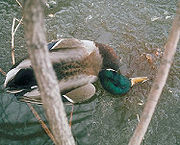
Duck plague
Encyclopedia
Introduction

Herpesviridae
The Herpesviridae are a large family of DNA viruses that cause diseases in animals, including humans. The members of this family are also known as herpesviruses. The family name is derived from the Greek word herpein , referring to the latent, recurring infections typical of this group of viruses...
that causes acute disease with high mortality rates in flocks of duck
Duck
Duck is the common name for a large number of species in the Anatidae family of birds, which also includes swans and geese. The ducks are divided among several subfamilies in the Anatidae family; they do not represent a monophyletic group but a form taxon, since swans and geese are not considered...
s, geese and swans. It is spread both vertically
Vertical transmission
Vertical transmission, also known as mother-to-child transmission, is the transmission of an infection or other disease from mother to child immediately before and after birth during the perinatal period. A pathogen's transmissibility refers to its capacity for vertical transmission...
and horizontally
Horizontal transmission
Horizontal transmission is the transmission of a bacterial, fungal, or viral infection between members of the same species that are not in a parent-child relationship....
- through contaminated water and direct contact. Migratory waterfowl
Bird migration
Bird migration is the regular seasonal journey undertaken by many species of birds. Bird movements include those made in response to changes in food availability, habitat or weather. Sometimes, journeys are not termed "true migration" because they are irregular or in only one direction...
are a major factor in the spread of this disease as they are often asymptomatic carriers
Asymptomatic
In medicine, a disease is considered asymptomatic if a patient is a carrier for a disease or infection but experiences no symptoms. A condition might be asymptomatic if it fails to show the noticeable symptoms with which it is usually associated. Asymptomatic infections are also called subclinical...
of disease. The incubation period
Incubation period
Incubation period is the time elapsed between exposure to a pathogenic organism, a chemical or radiation, and when symptoms and signs are first apparent...
is three to seven days. DVE is not zoonotic.
Clinical Signs & Diagnosis
Sudden and persistent increases in flock mortality is often the first observation of DEV. Symptoms in individual birds include loss of appetite, decreased egg production, nasal discharge, increased thirst, diarrheaDiarrhea
Diarrhea , also spelled diarrhoea, is the condition of having three or more loose or liquid bowel movements per day. It is a common cause of death in developing countries and the second most common cause of infant deaths worldwide. The loss of fluids through diarrhea can cause dehydration and...
, ataxia
Ataxia
Ataxia is a neurological sign and symptom that consists of gross lack of coordination of muscle movements. Ataxia is a non-specific clinical manifestation implying dysfunction of the parts of the nervous system that coordinate movement, such as the cerebellum...
, tremors and a drooped-wing appearance. Most ducks that show symptoms eventually die - mortality may reach 90 percent.
Due to the formation of diptheroid plaques on the eyelids and the mucosae of the respiratory system and gastrointestinal system the bird may show ophthalmic signs and refuse to drink.
Diagnosis can usually be made based on the clinical signs and postmortem findings:
On post-mortem, petechial haemorrhage in the conjunctivae, mucous membranes, trachea
Trachea
Trachea may refer to:* Vertebrate trachea, or windpipe, in terrestrial vertebrates, such as birds and mammals* Invertebrate trachea, in terrestrial invertebrates, such as insects and crustaceans* Vessel elements in plants...
, syrinx
Syrinx
In classical mythology, Syrinx was a nymph and a follower of Artemis, known for her chastity. Pursued by the amorous Greek god Pan, she ran to the river's edge and asked for assistance from the river nymphs. In answer, she was transformed into hollow water reeds that made a haunting sound when...
and intestine
Intestine
In human anatomy, the intestine is the segment of the alimentary canal extending from the pyloric sphincter of the stomach to the anus and, in humans and other mammals, consists of two segments, the small intestine and the large intestine...
are pathognomonic for DEV.
Treatment & Control
VaccinationVaccination
Vaccination is the administration of antigenic material to stimulate the immune system of an individual to develop adaptive immunity to a disease. Vaccines can prevent or ameliorate the effects of infection by many pathogens...
for duck viral enteritis is now routine in the United States. Only attenuated vaccines are efficacious. Once DVE is present, depopulation, relocation and intensive disinfection are required to overcome an outbreak. Solid natural immunity
Immunity (medical)
Immunity is a biological term that describes a state of having sufficient biological defenses to avoid infection, disease, or other unwanted biological invasion. Immunity involves both specific and non-specific components. The non-specific components act either as barriers or as eliminators of wide...
develops in recovered birds.
Management practices such as preventing exposure to wild waterfowl and contaminated water and screening of new stock should be performed to prevent disease.
External links
- Duck Viral Enteritis, expert reviewed and published by Wikivet at http://en.wikivet.net/Duck_Viral_Enteritis, accessed 01/09/2011

